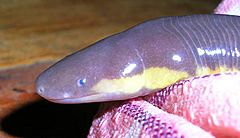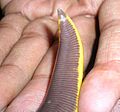Ichthyophiidae facts for kids
Quick facts for kids Asiatic tailed caecilians |
|
|---|---|
 |
|
| Ichthyophis sp. from the Western Ghats | |
| Scientific classification | |
| Kingdom: | |
| Phylum: | |
| Class: | |
| Order: | |
| Family: |
Ichthyophiidae
Taylor, 1968
|
| Genera | |
|
Caudacaecilia |
|
Ichthyophiidae is a family of amazing creatures called Asiatic tailed caecilians, also known as fish caecilians. These animals are a type of amphibian, just like frogs and salamanders. They mostly live in parts of south-east Asia.
Caecilians look a bit like large worms or snakes, but they are actually amphibians without legs. The Asiatic tailed caecilians are considered quite "old" in their family tree. This means they have some features that other, more modern caecilians do not. For example, they have a tail, and their bodies are covered in many small scales. Unlike some other caecilians, their mouth is not tucked far back under their head. They also have a special set of two muscles to close their jaw, which is unique among caecilians!
Contents
What are Caecilians?
Caecilians are a group of amphibians that are often mistaken for snakes or worms because they don't have legs. They live mostly underground or in water. There are many different kinds of caecilians found around the world, especially in tropical areas. They are a very interesting part of the animal kingdom!
Where They Live
As their name suggests, Asiatic tailed caecilians are found in Asia, specifically in the south-eastern parts. They prefer moist environments, often living in the soil or near streams and underground water sources. Their bodies are perfectly suited for burrowing through soft earth.
Special Features of Asiatic Tailed Caecilians
These caecilians have several unique traits that make them stand out:
- Tails: Many caecilians don't have tails, but the Asiatic tailed caecilians do! This is one of their defining features.
- Scales: Their skin has many small scales, which is unusual for amphibians.
- Mouth Position: Their mouth is not hidden far back under their head, making them look a bit different from some other caecilian families.
- Strong Jaws: They have two sets of muscles that help them close their jaws. This strong bite helps them catch their food.
Life Cycle and Reproduction
Asiatic tailed caecilians have an interesting way of reproducing. The females lay their eggs in small holes they dig in moist soil. After the eggs are laid, there's a good chance the mother stays with them. She might even protect the eggs until they hatch!
When the eggs hatch, tiny baby caecilians, called larvae, emerge. These larvae often live in streams or underground water flows. As they grow, they change and develop into adult caecilians, ready to live their lives mostly hidden beneath the surface.
Genera of Ichthyophiidae
The family Ichthyophiidae includes three main groups, or genera:
- Caudacaecilia
- Ichthyophis
- Uraeotyphlus
Each of these groups contains several different species of tailed caecilians, all sharing the special features of this family.
See also
 In Spanish: Ictiofíidos para niños
In Spanish: Ictiofíidos para niños
Images for kids


